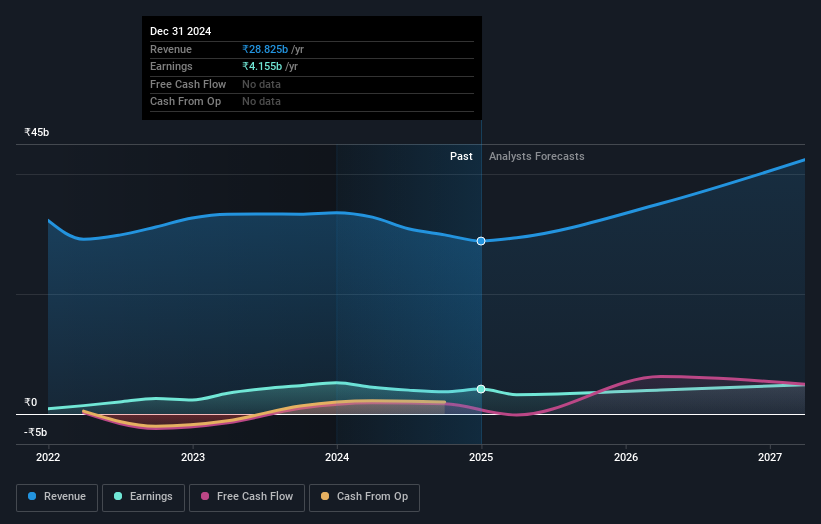- India
- /
- Construction
- /
- NSEI:ENGINERSIN
State or government among Engineers India Limited's (NSE:ENGINERSIN) largest shareholders, saw gain in holdings value after stock jumped 12% last week

Key Insights
- Engineers India's significant state or government ownership suggests that the key decisions are influenced by shareholders from the larger public
- The largest shareholder of the company is India with a 51% stake
- Institutions own 19% of Engineers India
A look at the shareholders of Engineers India Limited (NSE:ENGINERSIN) can tell us which group is most powerful. The group holding the most number of shares in the company, around 51% to be precise, is state or government. That is, the group stands to benefit the most if the stock rises (or lose the most if there is a downturn).
As a result, state or government collectively scored the highest last week as the company hit ₹101b market cap following a 12% gain in the stock.
In the chart below, we zoom in on the different ownership groups of Engineers India.
View our latest analysis for Engineers India

What Does The Institutional Ownership Tell Us About Engineers India?
Institutions typically measure themselves against a benchmark when reporting to their own investors, so they often become more enthusiastic about a stock once it's included in a major index. We would expect most companies to have some institutions on the register, especially if they are growing.
As you can see, institutional investors have a fair amount of stake in Engineers India. This can indicate that the company has a certain degree of credibility in the investment community. However, it is best to be wary of relying on the supposed validation that comes with institutional investors. They too, get it wrong sometimes. When multiple institutions own a stock, there's always a risk that they are in a 'crowded trade'. When such a trade goes wrong, multiple parties may compete to sell stock fast. This risk is higher in a company without a history of growth. You can see Engineers India's historic earnings and revenue below, but keep in mind there's always more to the story.

Engineers India is not owned by hedge funds. India is currently the largest shareholder, with 51% of shares outstanding. This essentially means that they have extensive influence, if not outright control, over the future of the corporation. In comparison, the second and third largest shareholders hold about 2.6% and 2.2% of the stock.
While studying institutional ownership for a company can add value to your research, it is also a good practice to research analyst recommendations to get a deeper understand of a stock's expected performance. There is a little analyst coverage of the stock, but not much. So there is room for it to gain more coverage.
Insider Ownership Of Engineers India
While the precise definition of an insider can be subjective, almost everyone considers board members to be insiders. The company management answer to the board and the latter should represent the interests of shareholders. Notably, sometimes top-level managers are on the board themselves.
Most consider insider ownership a positive because it can indicate the board is well aligned with other shareholders. However, on some occasions too much power is concentrated within this group.
Our data suggests that insiders own under 1% of Engineers India Limited in their own names. It's a big company, so even a small proportional interest can create alignment between the board and shareholders. In this case insiders own ₹871k worth of shares. It is good to see board members owning shares, but it might be worth checking if those insiders have been buying.
General Public Ownership
The general public-- including retail investors -- own 30% stake in the company, and hence can't easily be ignored. While this size of ownership may not be enough to sway a policy decision in their favour, they can still make a collective impact on company policies.
Next Steps:
It's always worth thinking about the different groups who own shares in a company. But to understand Engineers India better, we need to consider many other factors. For example, we've discovered 1 warning sign for Engineers India that you should be aware of before investing here.
Ultimately the future is most important. You can access this free report on analyst forecasts for the company.
NB: Figures in this article are calculated using data from the last twelve months, which refer to the 12-month period ending on the last date of the month the financial statement is dated. This may not be consistent with full year annual report figures.
Valuation is complex, but we're here to simplify it.
Discover if Engineers India might be undervalued or overvalued with our detailed analysis, featuring fair value estimates, potential risks, dividends, insider trades, and its financial condition.
Access Free AnalysisHave feedback on this article? Concerned about the content? Get in touch with us directly. Alternatively, email editorial-team (at) simplywallst.com.
This article by Simply Wall St is general in nature. We provide commentary based on historical data and analyst forecasts only using an unbiased methodology and our articles are not intended to be financial advice. It does not constitute a recommendation to buy or sell any stock, and does not take account of your objectives, or your financial situation. We aim to bring you long-term focused analysis driven by fundamental data. Note that our analysis may not factor in the latest price-sensitive company announcements or qualitative material. Simply Wall St has no position in any stocks mentioned.
About NSEI:ENGINERSIN
Engineers India
An engineering consultancy company, provides design, engineering, procurement, construction, and integrated project management services for oil, gas, fertilizers, steel, railways, power, infrastructure, and petrochemical industries worldwide.
Flawless balance sheet with proven track record and pays a dividend.
Similar Companies
Market Insights
Community Narratives



